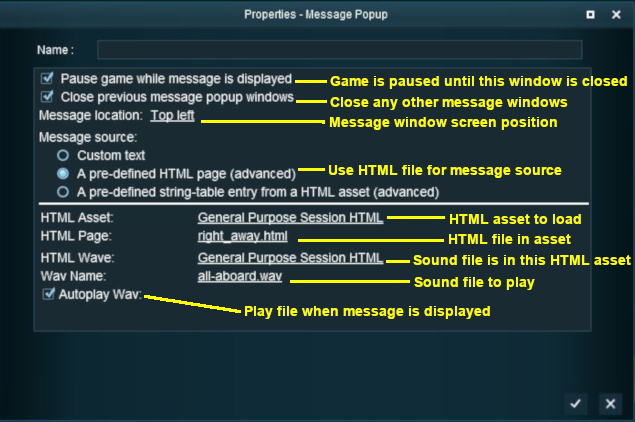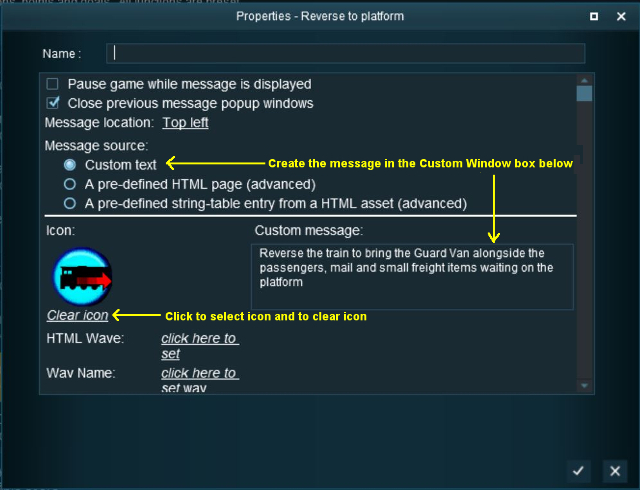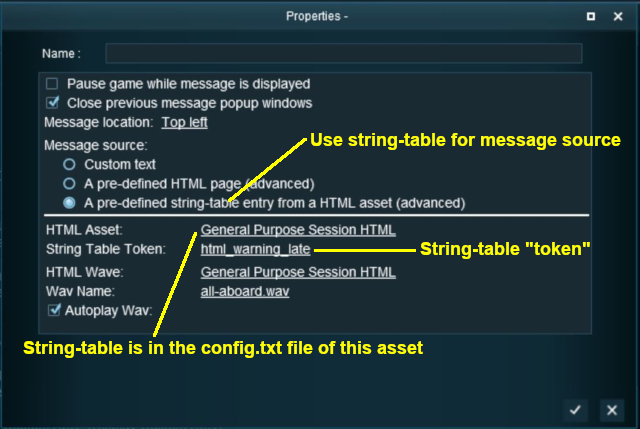How to Use Message Popup Rule
m (→Trainz Wiki) |
m (→Using a HTML Page) |
||
| Line 26: | Line 26: | ||
<br> | <br> | ||
'''Notes:''' | '''Notes:''' | ||
| − | *If you are creating your own HTML | + | *If you are creating your own HTML page then knowledge of HTML, as used by TANE, will be required. |
| − | *The HTML | + | *The HTML page (with filename extension ".html") must be in a Trainz asset of type HTML. |
*Graphics and a limited set of HTML effects are possible. | *Graphics and a limited set of HTML effects are possible. | ||
*The sound file settings '''HTML Wave''' and '''Wave Name''' are optional. | *The sound file settings '''HTML Wave''' and '''Wave Name''' are optional. | ||
| Line 37: | Line 37: | ||
</table> | </table> | ||
<br> | <br> | ||
| + | |||
='''Using a Custom Message'''= | ='''Using a Custom Message'''= | ||
Revision as of 23:32, 7 July 2018
Contents |
| The Message Popup Rule is a T:ANE Session Rule that creates onscreen messages for users in Driver Mode. |
The screenshots below illustrate how to use the Message Popup Rule.
Using a HTML Page
The settings shown in this example will direct TANE to load the message from a HTML file in a HTML asset.
 |
Settings in This Example:
|
Using a Custom Message
The settings shown in this example will direct TANE to load the message from text entered in the Custom Message box.
 |
Settings in This Example:
|
 |
The custom message popup created by the example shown above |
Using a String-Table Message
The settings shown in this example will direct TANE to load the message from text stored in the config.txt string table of a specified HTML asset.
 |
Notes:
string-table
{
html_warning_late "You are running late!"
}
...which will produce the message "You are running late!" from the Message Popup Rule settings shown on the left.
|
Trainz Wiki
- How to Guides
- Session Rules List (Alphabetical) with Parameters
- Session Rules List (Categories) With Parameters
Route Creation Tutorials:
Session Creation Tutorials:
- Adding Message Popups - Applications
- Adding Navigation Points
- Adding Navigation Points - Applications
- Configuring the Driver Setup Rule
- Controlling Junctions in Sessions
- Controlling Signals in Sessions
- Creating a HTML Asset (Session Introduction Page and In Game Messages)
- List of Parent Rules
- Parent and Child Rules
- Using Track Triggers
- Using Variables in Sessions - Examples